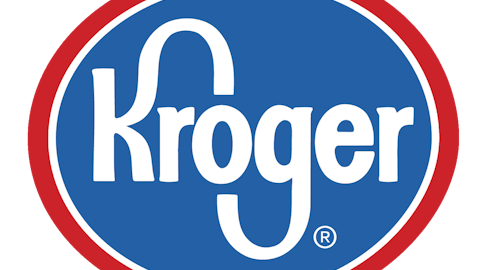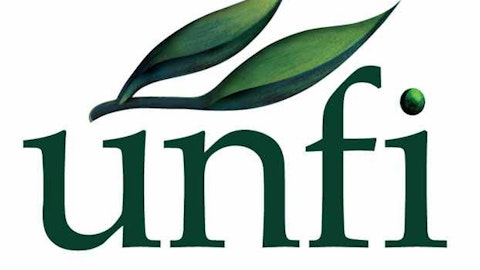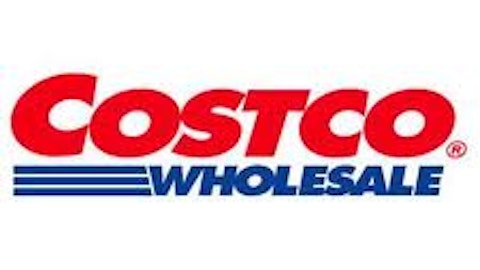Fast growing companies usually develop a following of investors that are willing to pay a premium for the company’s future growth. What’s ironic is, most of these investors defend their choice by quoting how much money they have already made on the stock. The problem is, knowing that someone else made money on a stock tells a new investor absolutely nothing about whether they should be the next to buy shares. While shares of Whole Foods Market, Inc. (NASDAQ:WFM) have been on a tear, buying shares today is a different proposition than years ago.
Organic Growth
Fast growing companies normally show good organic growth in sales, and in the case of a grocer like Whole Foods, they show strong same-store sales growth as well. The differentiating factor for Whole Foods is they offer a large selection of organic foods, as opposed to the traditional offerings of a regular grocery store.
While Whole Foods Market, Inc. (NASDAQ:WFM) is a larger company, The Fresh Market Inc (NASDAQ:TFM) is another company looking to capitalize on the strength of the organic foods industry. In addition, companies like The Kroger Co. (NYSE:KR) and Wal-Mart Stores, Inc. (NYSE:WMT) may not offer full organic selections, but they offer just enough organic options to keep shoppers from going elsewhere.
One of the best ways to measure organic growth is by looking at same-store sales. With any retailer, strong same-store sales growth is critical. There is no doubt that Whole Foods Market, Inc. (NASDAQ:WFM) same-store sales growth in the current quarter of 6.9% is excellent. Compared to The Kroger Co. (NYSE:KR)’s same-store sales growth of 3%, The Fresh Market Inc (NASDAQ:TFM)’s growth of 3%, or Wal-Mart Stores, Inc. (NYSE:WMT)’s 1.4% decline, clearly Whole Foods performed better. However, this brings us to the first problem facing Whole Foods. The company’s same-store sales are slowing down.
Have Investors Read The Earnings Report?
Over the last five quarters, Whole Foods Market, Inc. (NASDAQ:WFM) same-store sales grew by 8.9% five quarters ago, to 8.9%, 8.5%, 7.2%, and 6.9% in the current quarter. In case investors expect same-store sales to accelerate in the future, I would suggest looking at the company’s outlook for the third and fourth quarter of this year.
The significant slowdown in earnings growth at Whole Foods Market, Inc. (NASDAQ:WFM) is the second issue that investors might not be prepared for. Whole Foods is expected to grow earnings by nearly 18% over the next few years, but management is projecting just 7% to 10% EPS growth in the last two quarters of the year. Investors don’t like being disappointed. A company that has been growing earnings by 20% or more, that all of a sudden posts just 10% growth, could be a rude awakening for investors expecting more.
The third issue that Whole Foods Market, Inc. (NASDAQ:WFM) is dealing with is, the company’s cash flow isn’t as impressive as their earnings growth. In the current quarter, the company’s EPS grew by 19%, but their core operating cash flow (net income + depreciation) increased by 17.34%. Whenever operating cash flow lags EPS growth, you know there could be trouble if EPS growth slows further. Earnings can be manipulated, but net income plus depreciation, essentially determines how much the company has to spend on expansion, dividends, and share repurchases.
If Whole Foods Market, Inc. (NASDAQ:WFM) turns in lower EPS growth as they expect, operating cash flow growth will be lower. With less cash to fund expansion, it may be harder for the company to open the 32 stores they expect this year, without dipping into the cash on their balance sheet. For a relatively young company like Whole Foods, you would hope that organic cash flow could fund expansion. If the company’s cash flow doesn’t allow management to continue growing like they plan, a weaker balance sheet could be the result.
The Valuation Is No Bargain Either
The truth is, Whole Foods stock is relatively more expensive than all of their peers. When comparing companies that pay dividends with those that don’t, I like to use the PEG+Y ratio. This ratio takes the growth rate, adds the yield, and then divides by the projected P/E ratio. This allows investors to see the effect dividends have on a company’s total valuation. Unlike a traditional PEG ratio, in this case the higher the number, the better.
Whole Foods Market, Inc. (NASDAQ:WFM) pays a yield of about 0.75%, and the company’s growth in earnings is expected to be about 18%. However, investors seem to be expecting something more, considering that shares trade for over 36 times projected earnings. Using the PEG+Y valuation, the stock carries a ratio of 0.52. By comparison, The Fresh Market Inc (NASDAQ:TFM) has no yield, but a higher growth rate (20.30%) and a lower P/E ratio (32.15), which gives the company a ratio of 0.63.
The Kroger Co. (NYSE:KR) offers a relatively better value. The company’s yield of 1.75%, and growth of 7.3%, might not sound that good, but the stock sells for just 12.4 times projected earnings, or a PEG+Y of 0.73. Of the group, Wal-Mart Stores, Inc. (NYSE:WMT) offers the best combination, with a 2.43% yield, 9.29% growth, and a P/E ratio of 14.56. Walmart’s PEG+Y ratio of 0.80 easily beats all of their peers.
The point is, Whole Foods is relatively expensive, same-store sales are slowing down, and the back half of the year looks challenging. The stock has been on a tremendous run, but I would caution investors about adding to their positions at these levels. Remember, it doesn’t matter what other people have made on the stock, if you buy today, you have to look at what you can expect in the future.
Chad Henage has no position in any stocks mentioned. The Motley Fool recommends The Fresh Market and Whole Foods Market (NASDAQ:WFM). The Motley Fool owns shares of Whole Foods Market. Chad is a member of The Motley Fool Blog Network — entries represent the personal opinion of the blogger and are not formally edited.
The article Are Investors Ignoring These 3 Problems? originally appeared on Fool.com and is written by Chad Henage.
Copyright © 1995 – 2013 The Motley Fool, LLC. All rights reserved. The Motley Fool has a disclosure policy.





